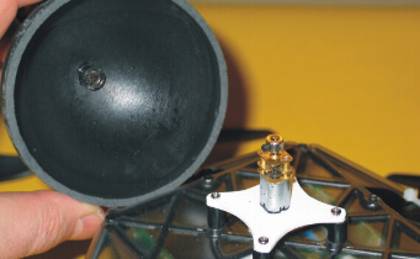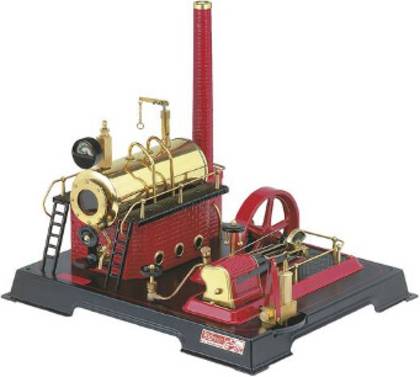Guide
This text is machine translated.
RC motors - the power suppliers in model construction
In modeling it is just like in real life: Among the engine hoods of sleek sports cars, elegant artificial airplanes or arrow-fast racing boats, a powerful drive has to provide appropriate propulsion. The driving or flying pleasure remains very fast on the track. How good that hobbyists, tinkerers and model makers can really draw from the full potential of the drives. So it is no wonder that some models have driving and flying power, which the owners of the originals can only dream of.
Useful information about RC motors
Which drive is the right drive for my model?
What was better: Electric motor or combustion engine?
What are the advantages of a drive set?
When is a geared motor required?
Model steam engines
Which drive is the right drive for my model?
A few years ago, this question was not a question. Because high-speed model combustion engines, which were fired with methanol, oil and abundant nitro, moved model cars and aircraft models through the area and spread a corresponding background noise with the associated exhaust flags to the delight of their owners. And that was good for decades. The combustion engines were offered in a wide variety of designs and sizes and continuously improved over the years. So a large part of the model makers decided to use methanol engines for powerful car and flight models. In order to avoid the sometimes unpleasant noise emission of the high-rotating two-stroke engines, four-stroke engines were also used in flight models, which had a clearly more pleasant running noise.
Yes, the models were soaked with the residual oil from the exhaust from the front to the rear, but the electric group did not do much better years ago either: Collector motors were operated at the power limit - and partly also above - to achieve reasonably usable flight and driving performance. Heavy NiCd or NiMH rechargeable batteries were used as power supply and the brush fire of the motors was responsible for some disturbance of the remote control signals. As a result, the electric drive still offered plenty of room for improvement.
What was better: Electric motor or combustion engine?
The electric drive of car, airplane and ship models has experienced a real revolution in recent years. Because with the new technology everything has become much better. In flight models, the propellers are now mounted directly on high-torque brushless external rotor electric motors and technically sophisticated speed controllers take over the sensitive dosage of the drive power. In car models, high-speed brushless internal rotor electric motors provide the necessary power when accelerating. And because the new brushless motors (brushless = brushless) do not require carbon brushes, the former radio interference caused by brush fires is a relic of past days.
But the power supply of the electric power packs also works better. This is done nowadays via high-capacity LiPo batteries, which enable long operating times and a high performance throughput.
If you think that combustion engines have disappeared completely from the picture, you're wrong. After all, these engines undoubtedly offer outstanding advantages, which many modelers appreciate.
Thanks to powerful electric drive up to 100 km/h fast
| Electric drive | Combustion drive | |
|---|---|---|
| Advantages: | Easy handling ideal for beginners | Powerful |
| Low noise emission enables use in residential areas | Long operating times thanks to low consumption | |
| No combustion residue (model remains clean) | After a short break in the tank, it is ready for use again | |
| Powerful | Operating noise suitable for the model | |
| Rapid deployment of performance | ||
| Motor can also take over the brake function | ||
| Brushless motors maintenance and wear-free | ||
| Disadvantages: | Operation requires a charged battery | Not permitted everywhere due to noise emission |
| Replacement batteries are required for longer periods of use | Oil levels on the model | |
| High-quality chargers are required for fast charging | Sound basic knowledge is required for handling the engine or adjusting the carburetor | |
| Drive batteries are subject to aging | Delayed throttle response due to design | |
| Missing or incorrect motor noise in prototypical models | Regular maintenance and care |
As you can see, both drive variants have valid advantages and also non-concealable shortcomings. In the end, every model maker has to decide for himself which drive concept he wants to use in his model.
In practice, however, a clear trend toward electric drives can be observed because these drives are much easier to handle. In terms of performance, the brushless electric motors have now caught up with the combustion engines, not to say even overtaken. Only large models still use high-capacity petrol engines.
What are the advantages of a drive set?
If the choice of an electric motor has fallen, the question arises at the same time which controller/speed controller best fits for the selected motor.
This question, which is often not easy to answer, can be easily avoided if you decide to use a drive set. These sets contain a motor suitable for the model and the speed controller or speed controller perfectly tuned to the motor. In addition, the propellers are also included in the delivery in the sets for flight models.

In a drive set, the components are perfectly matched.
Practical advice
With a brushless drive set, model cars can be tuned wonderfully! If your vehicle model is equipped with a 1:10 scale ex works with a simple collector motor (electric motor with carbon brushes or sliding contacts) of size 540, the desire for more power is very soon created. With a brushless set, the solution can be easily created. The fixing holes on the motors are identical, so that the brushed motor can be replaced with the brushless motor without major modifications. The existing brushed controller for the collector motor is replaced by the brushless controller from the set. And instead of the NiMH rechargeable battery, a LiPo rechargeable battery provides the optimum power supply.
Attention important!
Observe the speeds of the motors. If the brushless motor has a significantly higher speed than the previously used brush motor, a smaller motor pinion must be used. Only then can the brushless motor reach its rated speed and deliver the maximum possible power.
When is a geared motor required?

Due to its design, an electric motor is designed for a certain speed (rated speed) at which it operates most efficiently. In a model airplane with direct drive, a brushless motor operates at a speed below 10,000 revolutions per minute, whereas the electric motor in a small aerobatic helicopter has up to 40,000 revolutions per minute on the motor shaft. For this reason, the kV value is specified for brushless motors. This value indicates the revolutions per volt. If a motor with 600 kV is operated on a three-cell LiPo battery with a rated voltage of 11.1 V, the motor reaches a maximum speed of 6660 revolutions per minute.
If you put so much strain on an electric motor that it doesn't manage to reach its "feel-good speed", you have to expect negative consequences. The current consumption increases enormously, whereby the motor, the speed controller and also the battery become very hot and can take damage. In this case, a reduction gear must be used or the gear reduction already available in a model helicopter or in a model car must be adjusted using the motor pinion.
Electric motors with upstream gears are used for functional model construction, e.g. for driving track tracks or for the realization of slow turning movements of all kinds. The advantage of the geared motors is obvious, the gears are a compact part of the motor, which makes installation much easier. Often identical geared motors with different ratios are offered, which makes it very easy to find the perfect motor.
With a bit of talent for handicrafts and a touch of the fingertip, you can even convert a quadrocopter to a flying disco ball, in which a small gear motor can rotate the ball.
Here you can see the mirror ball quadrocopter in use. The take-off and landing took place on a terrace, where the light points of the mirror ball can be seen on the stone slabs.
Model steam engines

Originally in the 18th century. The steam engines were constantly improved and further developed. Thus, they were able to make a significant contribution to the first industrial revolution, until they were then at the beginning of the 20th century. Electric and internal combustion engines were replaced by the 20th century. Only the steam turbines have survived the time and are still used in power generation.
With a model steam engine on a reduced scale, you can bring the engineering art of past years back to life.
As with the large models, water is brought to the boil in a pressure vessel and a piston is moved with the steam. The piston movement then drives a large flywheel.
The rotational energy of the flywheel can be transferred to a wide variety of tools, such as saws, drills or sanding blocks, using a transmission mechanism with drive shafts. Just as it was practiced centuries ago.